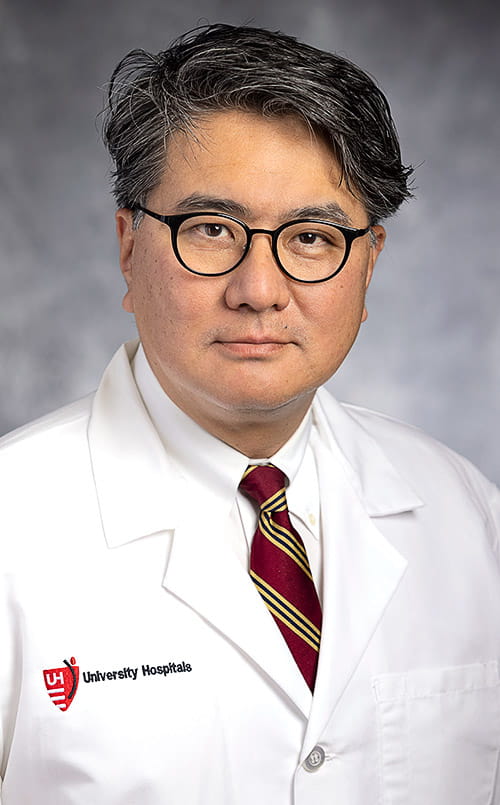University Hospitals Vascular Surgeon Provides National Leadership on Median Arcuate Ligament Syndrome (MALS)
June 20, 2023
Condition is unusual, often debilitating
Innovations in Cardiovascular Medicine & Surgery | Summer 2023
W. Michael Park, MD, first encountered median arcuate ligament syndrome (MALS) during his vascular surgery fellowship training at Mayo Clinic. The condition occurs when the median arcuate ligament drapes over and compresses the celiac axis, which supplies blood to the liver, stomach, pancreas and spleen.
 W. Michael Park, MD
W. Michael Park, MD“It’s one of those conditions that just isn’t taught in medical school,” says Dr. Park, now a vascular surgeon with University Hospitals Harrington Heart & Vascular Institute. “But it's far more common than people appreciate. There are a couple thousand cases of MALS treated every year in the U.S.”
Patients with suspected MALS, most of whom are young or middle-aged women, report a feeling of tightness in the upper abdomen, like a belt being cinched too tightly, Dr. Park says. And they develop pain when eating, often losing a significant amount of weight and becoming fearful of eating as a result.
Because MALS mimics gastrointestinal conditions like gallbladder disease or pancreatitis, the diagnosis can be difficult, Dr. Park says.
“It may go unrecognized for years,” Dr. Park says. “We’ve got young and middle-aged patients who are in their most productive years, and it can be incapacitating. And it can be traumatic as they get ruled out for more common diseases and told by well-meaning practitioners, unaware of MALS, variations on ‘it must be all in your head.’”
Providing Leadership on MALS
Now more than 20 years after that first MALS case in fellowship, Dr. Park is playing a leading role nationally in improving diagnosis and treatment for MALS, as well as becoming an advocate for patients. He is one of just six physicians on the National MALS Foundation Clinical Advisory Board. In fact, patients both regionally in the Midwest and across the country have self-referred to Dr. Park for MALS diagnosis and treatment as a result of the organization’s social media presence.
In addition, Dr. Park and a group of national colleagues just published research in the journal Surgical Endoscopy detailing the current standard of care for MALS. Their analysis of MALS 763 cases from 2010 to 2020, using the American College of Surgeons-National Surgical Quality Improvement Project, showed a shift toward a laparoscopic approach to surgical care.
“Overall numbers of surgical intervention for treatment of median arcuate ligament increased during this timeframe, as well as increased utilization of the laparoscopic approach,” Dr. Park says. “It appears to be an overall safe procedure, offering lower rates of complications and shorter length of stay.”
A Challenging Diagnosis
Dr. Park says he typically sees patients with suspected MALS after a gastroenterologist has already performed an upper endoscopy or upper GI series and has ruled out gastrointestinal causes. The next step is ultrasound – the gold standard, he says.
“The sonographer checks the blood flow with the patient in full inspiration and expiration,” he says. “In inspiration, everything gets pushed downwards, and the angle is relaxed, and the blood flow should be fairly normal. In expiration, the compression is maximized, and the velocity inside the blood vessel should be elevated, if there is significant compression.”
Next comes a CT scan to map the anatomy and help with surgical planning, as well as a detailed patient history to make sure there are no atherosclerotic risk factors that may be to blame for the patient’s symptoms. The last step is a celiac plexus nerve block, done under fluoroscopy guidance.
“It deadens those nerves that are crushed,” Dr. Park says. “If patients have relief of their symptoms through this temporary measure, that predicts that that the operation itself, in both cutting the ligament and those nerves, will succeed.”
Providing Relief
Dr. Park says he completes most of his MALS procedures laparoscopically, often letting general surgery take the lead. However, he’s quick to point out that vascular surgery has an essential role to play.
“I think it's optimal to have a vascular surgeon involved because in about 5 percent of these cases, there’s an injury to the artery that requires converting to a laparotomy,” he says. “One of the unique features of vascular surgery training is that we dissect out this area of the aorta and arteries frequently in our operations. It's an area of work where we’re very comfortable.”
Between 80 and 85 percent of patients report relief of their symptoms after the MALS surgical procedure, Dr. Park says.
Consolidating Expertise
Next, Dr. Park is working to establish and optimize a Vascular Compression Center within UH Harrington Heart & Vascular Institute. It would be a multidisciplinary collaboration between gastroenterology, general surgery, psychiatry, social work, pain management, vascular medicine and vascular surgery.
The challenging nature of MALS makes a multidisciplinary approach critical, he says.
“Patients do benefit from a laparoscopic approach,” Dr. Park says. “They can get complete release of the compression. It’s important to have a collaboration with gastrointestinal specialists, both surgeons and gastroenterologists, and have GI issues ruled out when considering treatment for MALS. We all have a role to play.”
For more information about treatment for MALS at UH Harrington Heart & Vascular Institute or to refer a patient, please call 216-844-3800.
Contributing Expert:
W. Michael Park, MD
Vascular Surgeon
UH Harrington Heart & Vascular Institute
Associate Program Director, Vascular Surgery Training Program
UH Cleveland Medical Center
Assistant Professor
Case Western Reserve University School of Medicine


